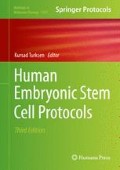Abstract
Rapid technological developments for the efficient generation of footprint-free induced pluripotent stem cells (iPSC) enabled the creation of patient-specific iPSC for downstream applications in drug discovery and regenerative medicine. However, the large number of iPSCs, generated from diverse genetic backgrounds using various methods and culture conditions, created a steep challenge for rapid characterization and a demand for standardized methods. Current methods rely on a combination of in vitro and in vivo cellular analyses based on the expression of markers of self-renewal and the ability of the cells to differentiate into cell types representative of the three germ layers as a confirmation of functional pluripotency. These methods, though informative and extensively used, are not ideal for parallel analyses of large numbers of samples and hence not amenable to high-throughput environments. Recently, genetic and epigenetic expression signatures were used to define and confirm cell states, thus providing a surrogate molecular assay that can potentially replace complex in vivo cellular assays such as teratoma formation.
In this chapter, we describe a molecular assay for rapid characterization and standardization of pluripotent stem cells. The TaqMan® hPSC Scorecard™ Panel is a comprehensive gene expression real-time PCR assay that consists of 94 individual q-PCR assays comprised of a combination of control, housekeeping, self-renewal, and lineage-specific genes. The resulting expression data set is analyzed using cloud-based analysis software that compares the expression pattern against a reference standard composed of multiple functionally validated ESC and iPSC lines. This system was successfully used to test several ESC and iPSC lines in their undifferentiated states to confirm their signatures of self renewal, as well as their terminally differentiates states, via spontaneous differentiation and directed differentiation into specific lineages, to determine the lines’ differentiation potential. This genetic analysis tool, together with the flexibility to utilize varying sample inputs and preparation methods, provides a rapid method to confirm functional pluripotency of ESCs and iPSCs.
Access this chapter
Tax calculation will be finalised at checkout
Purchases are for personal use only
References
Maherali N, Hochedlinger K (2008) Guidelines and techniques for the generation of induced pluripotent stem cells. Cell Stem Cell 3:595–605
Malik N, Rao MS (2013) A review of the methods for human iPSC derivation. Methods Mol Biol 997:23–33
Ko HC, Gelb BD (2014) Concise review: drug discovery in the age of the induced pluripotent stem cell. Stem Cells Transl Med 3:500–509
Rao M, Gottesfeld JM (2014) Introduction to thematic minireview series: development of human therapeutics based on induced pluripotent stem cell (iPSC) technology. J Biol Chem 289:4553–4554
Marti M, Mulero L, Pardo C et al (2013) Characterization of pluripotent stem cells. Nat Protoc 8:223–253
Wesselschmidt RL (2011) The teratoma assay: an in vivo assessment of pluripotency. Methods Mol Biol 767:231–241
Gertow K, Przyborski S, Loring JF et al (2007) Isolation of human embryonic stem cell-derived teratomas for the assessment of pluripotency. Curr Protoc Stem Cell Biol. Chapter 1:Unit1B 4
Muller FJ, Goldmann J, Loser P et al (2010) A call to standardize teratoma assays used to define human pluripotent cell lines. Cell Stem Cell 6:412–414
Daley GQ, Lensch MW, Jaenisch R et al (2009) Broader implications of defining standards for the pluripotency of iPSCs. Cell Stem Cell 4:200–201, author reply 202
Muller FJ, Schuldt BM, Williams R et al (2011) A bioinformatic assay for pluripotency in human cells. Nat Methods 8:315–317
Guenther MG, Frampton GM, Soldner F et al (2010) Chromatin structure and gene expression programs of human embryonic and induced pluripotent stem cells. Cell Stem Cell 7:249–257
Chin MH, Mason MJ, Xie W et al (2009) Induced pluripotent stem cells and embryonic stem cells are distinguished by gene expression signatures. Cell Stem Cell 5:111–123
Narsinh KH, Plews J, Wu JC (2011) Comparison of human induced pluripotent and embryonic stem cells: fraternal or identical twins? Mol Ther 19:635–638
Hu BY, Weick JP, Yu J et al (2010) Neural differentiation of human induced pluripotent stem cells follows developmental principles but with variable potency. Proc Natl Acad Sci U S A 107:4335–4340
Narsinh KH, Sun N, Sanchez-Freire V et al (2011) Single cell transcriptional profiling reveals heterogeneity of human induced pluripotent stem cells. J Clin Invest 121:1217–1221
Feng Q, Lu SJ, Klimanskaya I et al (2010) Hemangioblastic derivatives from human induced pluripotent stem cells exhibit limited expansion and early senescence. Stem Cells 28:704–712
Bock C, Kiskinis E, Verstappen G et al (2011) Reference maps of human ES and iPS cell variation enable high-throughput characterization of pluripotent cell lines. Cell 144:439–452
Acknowledgements
We thank Joanna Asprer for assistance with review of the manuscript.
Author information
Authors and Affiliations
Corresponding author
Editor information
Editors and Affiliations
Rights and permissions
Copyright information
© 2014 Springer Science+Business Media New York
About this protocol
Cite this protocol
Fergus, J., Quintanilla, R., Lakshmipathy, U. (2014). Characterizing Pluripotent Stem Cells Using the TaqMan® hPSC ScorecardTM Panel. In: Turksen, K. (eds) Human Embryonic Stem Cell Protocols. Methods in Molecular Biology, vol 1307. Humana Press, New York, NY. https://doi.org/10.1007/7651_2014_109
Download citation
DOI: https://doi.org/10.1007/7651_2014_109
Published:
Publisher Name: Humana Press, New York, NY
Print ISBN: 978-1-4939-2667-1
Online ISBN: 978-1-4939-2668-8
eBook Packages: Springer Protocols

